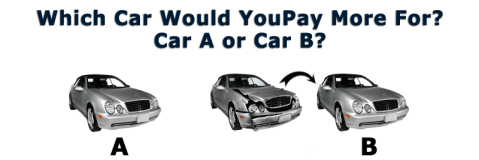|
When you are in an accident, there is more to
consider other than your immediate need for repairs to your vehicle,
and selecting a repair facility you can trust and rely on.
When your vehicle is damaged, it may very well lose
additional value even after the humanly best repair possible has
been performed. This is referred to as Diminished Value (DV).

The Insurer does not automatically offer you any
compensation for DV during your claim settlement. In addition, most
likely when it is demanded, the initial offer will not be what you
are entitled to as well.
There are three basic types of Diminished Value, and
whether you can collect for this loss varies by State, and the type
of claim is being settled such as a 1st party, 3rd party, uninsured
motorist, comprehensive, or no-fault. (Read - About Insurance)
Repair DV:
This is the loss of value due to the repairs
that were performed below an acceptable industry standard. This is
normally a result of poor workmanship, poor quality parts installed,
and/or poor products used for the repairs.
It is the goal of quality repairers to make the
repairs an "invisible repair" whenever possible. This is often
referred to as restoring a vehicle back to pre-accident condition
and appearance. However, even when following manufacturer repair
guidelines it may result in a repair that is not invisible.
Insurer DV:
This is the loss of value due to the insurer
denying payment to properly repair the vehicle, or by requiring the
usage of parts and materials which are not of "Like Kind and
Quality".
This is very difficult to collect since insurers
claim they only "just pay" for the damages as per the repairer
requests, and not make repair decisions, but they are much more
involved that this claim.
Inherent DV:
This loss is due to "perception of value lost"
just because it was damaged and even if it is repaired properly.
Why this occurs is difficult to prove because it is a
perception of value, a stigma to the vehicle owner or another buyer
that drives the loss.

States differ dramatically if and how you can
collect for Diminished Value. The main determining factor in
collecting for DV from your own insurance company is whether it is
part of the "contract" between them and you called your policy. In
many States it is not collectible due to that it is not covered in
your policy you purchased.
Several years ago there were a series of
litigations that claimed that it was included, but for the most part
the court agreed that it did not. However there are some States
which do consider it collectible as a 1st party claim. Indiana is
not considered as one of these States unless the specific insurance
company policy would have included it.
3rd Party Claims:
This type of claim where the other party is at fault does often
provide for payment for this loss in most cases in most States.
 How to Collect DV Damages
How to Collect DV Damages
To collect for DV loss very often requires a
process in many States that includes a vehicle inspection for
condition and evaluation. Often this
includes inspecting the vehicle after repairs are performed which is
also called a "post vehicle inspection". (Read Post Inspections)
The first steps are to determine if there is any
Repair DV to consider. Then with a market evaluation (or some States
use a formula based calculation to determine your loss) your damages
are established. Again, unfortunately in
many States this requires litigation or mediation to collect from
insurers. For assistance with Post
Inspections and DV Damages an expert in your area can be located by
Clicking Here |